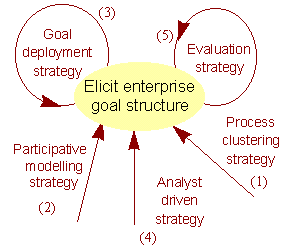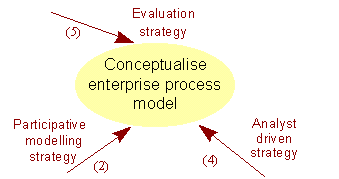
Strategy (2) is motivated by the desire to eat an "andouillette" in Lyon, where it originates from.
In strategy (3), time is not important whereas, visit as much as one can in the French site is key factor.
The page introduces the notion of a strategy as a means to reach an intention. It provides the two collections of EKD-CMM strategies applicable to the two key intentions Elicit Enterprise Goal Structure and Conceptualise Enterprise Business Process Model.
In EKD-CMM, a strategy characterises a manner to reach an EKD-CMM process
intention. For example, as shown below, EKD-CMM offers two strategies to
"Elicit Enterprise Goal Structure" : a Participative Modelling strategy
and an Analyst Driven strategy. Both are possible ways to reach the same
result, namely a goal structure modelled using concepts of the EKD goal
sub-model.
| Elicit Enterprise Goal Structure
following
Participative modelling strategy |
Elicit Enterprise Goal Structure following
Analyst driven strategy |
|
|
The electronic brainstorming strategy is appropriate when the organisational maturity of modelling is low, the participative involvement is low, the organisational culture is hierarchical and the problem is well-defined. |
The analogy can be made with a strategy to reach a location on a map.
For instance, to reach Nice from Paris, one can imagine three strategies
: fast, "andouillette", lazzy.
 |
With strategy (1), the idea is to reach Nice as fast as possible.
Strategy (2) is motivated by the desire to eat an "andouillette" in Lyon, where it originates from. In strategy (3), time is not important whereas, visit as much as one can in the French site is key factor. |
Similarly, the performance of the EKD-CMM modelling process is based
on strategies to reach one of the two key process intentions "Elicit enterprise
goal structure" and "Conceptualise enterprise business process model".
The proposed strategies are listed below.
 |
Elicit Enterprise Goal Structure
following :
1 - Process Clustering Strategy 2 - Participative Modelling Strategy 3 - Goal Deployment Strategy 4 - Analyst Driven Strategy 5 - Evaluation Strategy |
| Conceptualise Enterprise
BPM following :
2- Participative Modelling Strategy 5- Evaluation Strategy |
 |


